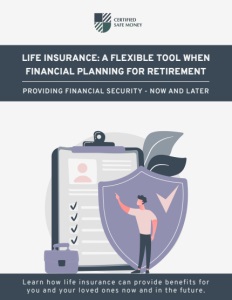Key Takeaways:
-
Life insurance policies can offer more than just a death benefit; they can be an integral part of your retirement strategy when used wisely.
-
Understanding the financial flexibility life insurance provides can help you create a more secure and diversified retirement plan.
Beyond the Basics: Life Insurance and Your Retirement
Life insurance is often viewed as a straightforward safety net for your loved ones. But did you know that certain policies can do much more than that? If you’re looking to strengthen your retirement plan, life insurance might hold the key to additional financial security, flexibility, and peace of mind. Let’s dive into how life insurance can be a game-changer for your golden years.
Understanding the Types of Life Insurance
Before discussing how life insurance supports retirement, it’s important to know the basic types:
-
Term Life Insurance: This provides coverage for a specific period, like 10, 20, or 30 years. It’s typically more affordable but doesn’t accumulate cash value.
-
Permanent Life Insurance: Includes whole life, universal life, and variable life insurance. These policies cover you for life (as long as premiums are paid) and may include a cash value component that grows over time.
For retirement purposes, permanent life insurance is often the focus because of its ability to build cash value and provide additional financial tools.
How Life Insurance Fits Into Retirement Planning
Building Cash Value
One of the most powerful features of permanent life insurance is its cash value. Over time, a portion of your premium payments grows tax-deferred. This cash value can be accessed in various ways during retirement, offering:
-
Supplemental Income: You can withdraw or borrow against the cash value to supplement your retirement income. This can be especially helpful in years when you want to avoid tapping into other investments.
-
Emergency Fund: The cash value serves as a financial cushion for unexpected expenses, from medical bills to home repairs.
Tax Advantages
Life insurance policies offer unique tax benefits that can complement your retirement plan:
-
Tax-Deferred Growth: Cash value grows without being taxed annually.
-
Tax-Free Loans: Borrowing against your cash value is typically tax-free as long as the policy remains active.
-
Estate Planning Benefits: Death benefits are generally tax-free to your beneficiaries, providing a financial legacy.
Bridging Medicare Gaps
If you plan to retire before becoming eligible for Medicare at age 65, you may face expensive health insurance premiums. The cash value in your life insurance can help cover these costs without jeopardizing other retirement savings.
Life Insurance Strategies for Retirement
Using the Policy’s Cash Value
The cash value in your life insurance policy can be accessed in several ways:
-
Withdrawals: You can withdraw funds directly from your cash value. Keep in mind that withdrawals may reduce the policy’s death benefit.
-
Policy Loans: Borrowing against your cash value doesn’t require credit checks or repayment schedules. However, unpaid loans can accrue interest and reduce the death benefit.
-
Surrendering the Policy: If you no longer need the death benefit, you can surrender the policy and receive the accumulated cash value. This option usually incurs surrender charges and tax consequences.
Funding Long-Term Care Needs
Some life insurance policies include riders for long-term care, allowing you to access the death benefit early to pay for long-term care expenses. This can be a practical way to prepare for potential healthcare needs without purchasing a separate long-term care insurance policy.
Pairing with Other Retirement Accounts
Life insurance works best when it’s part of a diversified retirement strategy. Here’s how it can complement other savings vehicles:
-
Traditional Retirement Accounts: Use life insurance to bridge gaps in income if you’re delaying Social Security benefits to maximize payouts.
-
Health Savings Accounts (HSAs): While HSAs cover healthcare costs, life insurance can handle unexpected expenses or gaps not covered by other accounts.
Key Considerations Before Using Life Insurance for Retirement
Evaluating Costs
Permanent life insurance policies are more expensive than term life insurance. Ensure that the additional costs align with your retirement goals and overall financial plan.
Balancing Death Benefits and Living Benefits
Using the cash value for retirement means the death benefit may be reduced. Consider your family’s needs when deciding how to use the policy.
Monitoring Policy Performance
Permanent life insurance policies, especially variable life insurance, may be tied to market performance. Regularly review your policy to ensure it meets your expectations.
When Should You Start?
The sooner you start a permanent life insurance policy, the more time the cash value has to grow. Ideally, beginning in your 30s or 40s allows decades for compound growth. However, it’s never too late to explore this option if you’re nearing retirement and looking for additional financial tools.
Common Questions About Life Insurance and Retirement
Can I Rely Solely on Life Insurance for Retirement?
While life insurance provides unique advantages, it should not replace traditional retirement savings accounts like IRAs or 401(k)s. Think of it as a complementary tool rather than a standalone solution.
What Happens If I Don’t Use the Cash Value?
If you don’t use the cash value, it remains in the policy and enhances the death benefit for your beneficiaries. This ensures your investment is never wasted.
How Do I Avoid Pitfalls?
To make the most of life insurance for retirement:
-
Choose a policy with transparent terms and manageable premiums.
-
Work with a financial professional to integrate it into your broader retirement plan.
-
Avoid over-borrowing from the cash value to keep the policy intact.
Making Life Insurance Work for You
Life insurance policies offer more than just peace of mind—they can serve as a versatile financial tool for your retirement. By understanding how to leverage cash value, tax benefits, and policy features, you can unlock new possibilities for financial security and flexibility in your golden years. Take the time to evaluate your options, discuss them with a trusted advisor, and ensure your policy aligns with your long-term goals.












